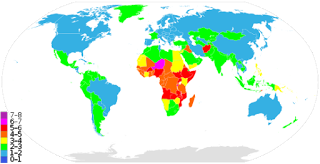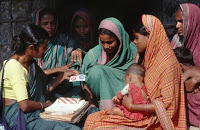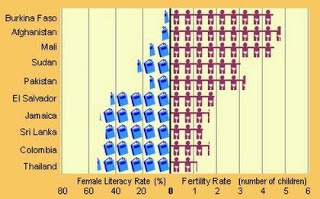The Population Problem: Not as Bad as You Might Think
 The EssentialsFirst the good news: great progress has already been made! It turns out women around the world are on board with zero population growth! It turns out zero population growth is not all that difficult or expensive to achieve! The bad news: the people with wealth and power in the world are largely uninterested in funding it.
The EssentialsFirst the good news: great progress has already been made! It turns out women around the world are on board with zero population growth! It turns out zero population growth is not all that difficult or expensive to achieve! The bad news: the people with wealth and power in the world are largely uninterested in funding it. Ok, let’s back up. The rapid expansion of human population past the finite limits of what our planet can support is a messy business if there ever was one, full of politics, religion, and basic human needs and desires. People worried about the fate of the planet like to despair about population growth to the point of paralysis. Why lift a finger to avert the climate and energy-depletion disaster ahead of us when overpopulation will do us in however much we insulate our homes, change out our light bulbs, ride our bikes, etc.
But the situation is not nearly so hopeless. Of the 224 countries in the world, the population growth rate is negative in 34 of them, including Cuba, Germany, Greece, Hungary, Japan, Latvia, Lithuania, Poland, Romania, Russia, and the Ukraine. These countries are not small potatoes. Russia and Japan are the ninth and tenth biggest countries in the world. (Note: population figures and most other data in this blogpost are from the CIA World Factbook, much of it recently updated for 2016.)
Let’s examine the essential drivers of world population growth: births per woman, mother’s mean age at first birth, and mean life expectancy.
Births per woman. Here’s the good news. This number has been dropping worldwide, falling from 5 in 1960 to 2.42 in 2016. In developed countries, the replacement fertility rate is generally considered to be 2.1 births per woman. (This accounts for those children who, through disease or accidents, do not reach reproductive age.) In very poor countries, the replacement fertility rate can be much higher. More good news: in a study of 40 countries, fertility rates between 1.5 and 2.0 are shown to generally bring economic benefits that lead to a higher standard of living.
 Births per woman by country (green good; blue better!)Births per woman in the US is now at 1.87, well below the replacement rate. But this number is actually high for a developed country. Out of the 224 countries in the world, 82 have lower fertility rates than the US, including developing countries such as Vietnam, Iran, Chile, Uruguay, Brazil, China, Thailand, and Cuba. Across the entire world, 136 countries are below 2.1 replacement rate fertility. That leaves just 88 countries to worry about.
Births per woman by country (green good; blue better!)Births per woman in the US is now at 1.87, well below the replacement rate. But this number is actually high for a developed country. Out of the 224 countries in the world, 82 have lower fertility rates than the US, including developing countries such as Vietnam, Iran, Chile, Uruguay, Brazil, China, Thailand, and Cuba. Across the entire world, 136 countries are below 2.1 replacement rate fertility. That leaves just 88 countries to worry about.I find the 80/20 rule useful in dividing big problems into smaller ones. In this case, 80% of the world’s population resides in the 34 most populous countries. Of these 34, eighteen countries already have fertility rates below the replacement rate of 2.1 (Brazil, China, Columbia, France, Germany, Iran, Italy, Japan, Poland, South Korea, Russia, Spain, Thailand, Turkey, Ukraine, United Kingdom, United States and Vietnam.) No need to worry about these countries.
 Bangladeshi feat (photo: Mark Edwards)Of the sixteen that remain, six countries have made great strides and are very close to the replacement fertility rate (and may already be below their own replacement fertility rate): Argentina (2.28), Bangladesh (2.19) Indonesia (2.13), Mexico (2.25), Myanmar (2.15), and South Africa (2.31). Birth control use is widespread in these countries, from 46% (Myanmar) to 72% (Mexico). These countries are likely to trend below 2.1 by 2020 or sooner. A special shout out to Bangladesh where a large percentage of the country lives on less than $2 a day. Their achievement in reducing their fertility rate has been so remarkable that they should probably be the ones now training everyone else how to do it.
Bangladeshi feat (photo: Mark Edwards)Of the sixteen that remain, six countries have made great strides and are very close to the replacement fertility rate (and may already be below their own replacement fertility rate): Argentina (2.28), Bangladesh (2.19) Indonesia (2.13), Mexico (2.25), Myanmar (2.15), and South Africa (2.31). Birth control use is widespread in these countries, from 46% (Myanmar) to 72% (Mexico). These countries are likely to trend below 2.1 by 2020 or sooner. A special shout out to Bangladesh where a large percentage of the country lives on less than $2 a day. Their achievement in reducing their fertility rate has been so remarkable that they should probably be the ones now training everyone else how to do it.That leaves ten countries to worry about. Of these, six have cut their fertility rate by at least half over the past 50 years: Algeria (2.74), Kenya (3.14) India (2.45), Pakistan (2.68), Egypt (3.53) and the Philippines (3.06). These countries could still use encouragement and financial support but they are not where the biggest part of the problem lies.
That leaves just four countries that need heavy-duty work on the fertility rate front: Tanzania (4.83 births per woman), Nigeria (5.13), Ethiopia (5.07), Congo DR (4.53). It’s not that these countries have made no improvements; they used to range from 6 to 7 births per woman. It’s just that they still have a long way to go. But worrying about four countries is much, much easier than worrying about 224. These four nations comprise 422 million people. Even within these countries there are bright spots. For example, in Addis Ababa, the capitol of Ethiopia, the fertility rate is already below population replacement levels.
 Early Birth Control ClinicThe task of reining in the fertility rate in these four countries seems daunting. Indeed, for decades many have insisted there was nothing to be done about over population because women would always have as many babies as they could. It turns out, however, that when given education and access to voluntary contraception, women all over the world--of all races, of all religions, on all continents--choose to have small families. Indeed, some women choose to have no children at all. This is how birthrates have fallen all over the world, even in Islamic countries like Turkey, Iran, and Bangladesh, even in Catholic countries like Poland, Mexico and Brazil. Perhaps this shouldn’t be a surprise since pregnancy and childbirth are no cakewalk; in fact, in some parts of the world both are quite dangerous. And women have long known that it’s easier to successfully raise children to adulthood the fewer one has to tend. In any event, the fact that, when given a choice, women prefer small families is great, great, stupendous news. If women didn’t have a natural predilection for small families, if we had to fight against women’s innate desires to avoid calamity, the world would indeed be in trouble. The true problem we face is that in developing countries 225 million women want to delay or stop childbearing but are uninformed about effective contraception or lack access to it.
Early Birth Control ClinicThe task of reining in the fertility rate in these four countries seems daunting. Indeed, for decades many have insisted there was nothing to be done about over population because women would always have as many babies as they could. It turns out, however, that when given education and access to voluntary contraception, women all over the world--of all races, of all religions, on all continents--choose to have small families. Indeed, some women choose to have no children at all. This is how birthrates have fallen all over the world, even in Islamic countries like Turkey, Iran, and Bangladesh, even in Catholic countries like Poland, Mexico and Brazil. Perhaps this shouldn’t be a surprise since pregnancy and childbirth are no cakewalk; in fact, in some parts of the world both are quite dangerous. And women have long known that it’s easier to successfully raise children to adulthood the fewer one has to tend. In any event, the fact that, when given a choice, women prefer small families is great, great, stupendous news. If women didn’t have a natural predilection for small families, if we had to fight against women’s innate desires to avoid calamity, the world would indeed be in trouble. The true problem we face is that in developing countries 225 million women want to delay or stop childbearing but are uninformed about effective contraception or lack access to it.Again, so we’re clear:
Education + Contraception + Women’s Innate Preference for Small Families = Low Fertility Rate.
What about men, you might ask? Don’t they matter to population growth rates? If men stopped having sex with women altogether, they might, but this appears to be against the innate preference of most of them. When men use birth control or are sterilized they matter to population control, but male sterilization is a hard sell worldwide, and male condoms, while cheap and better than nothing, have a high failure rate. Where men really count is insofar as they prevent women from getting educated or keep them from access to reliable forms birth control. This is not to say boys and men shouldn’t be educated. This is not to say it wouldn’t be helpful if men wanted small families, too. This is not to say it wouldn’t be great if we could come up with some kind of long-acting reversible form of birth control for men. But right now, it’s women and girls who impact fertility rates and population growth in a big way.
Now you might think this can’t be, that low fertility rates are an outcome of wealth not education. Women in poor countries have lots of children; women in rich countries don’t. But this ain’t necessarily so, as we can see when we plot the data from our 34 most populous countries:
 Births/Woman vs GDP/Capita
Births/Woman vs GDP/CapitaHigh GDP/capita countries have low fertility rates, but so do lots of low GDP/capita countries. What is predictive of fertility is women’s education, especially literacy.
 Births/Woman vs. Female Literacy Rate
Births/Woman vs. Female Literacy RateEducate girls and young women, births per woman go down.
 Notice a pattern? (UN data 2000)
Notice a pattern? (UN data 2000)Mean Age at First Birth. Why is this important? Imagine a cohort of ten women. If each them has a daughter at age 20 and a son at age 22, and if all their daughters do exactly the same, at the end of 102 years, 120 new human beings would result, with the last set of sons born in year 102. Now let’s imagine this same cohort, but change the women’s age at their children’s births to 25 and 27. At the end of 102 years, 100 new human beings would result, with the last set of sons born in year 102. A twenty percent difference! So you can see, spacing out the generations results in a substantial reduction in population growth.
For our 34 highest population countries, the mean age at first birth ranges from 18 to 30.3. What promotes a higher mean age at first birth? Well the number of years girls spend in school seems to correlate.
 Years at School vs. Mean Age at First Birth
Years at School vs. Mean Age at First BirthIf we want to raise mean age at first birth, it’s also a good idea to reduce the teen birth rate. This usually involves a combination of keeping girls in school and giving teens access to contraception. In developing countries, the average cost to educate a child for a year of lower secondary school with reasonable class size is $339. The average cost to educate a child for a year of upper secondary school with reasonable class size is $738. (It turns out children all over the world learn little when there are fifty kids per teacher.) Thirteen years of education for a child is roughly $5420, which comes out to $417/year. The cost to provide a woman with contraception in a developing country runs roughly $18/year. So let’s say 13 years of education and 15 years of contraception. Total lifetime cost: $5690.
 Technology that mattersOut of the 422 million people in these four nations most in need, roughly half are women, or 211 million. All these countries skew young with a median age of 18 – 19. This puts the number of girls in these five countries between the ages of 5 and 18 around 76 million. Right now roughly half of these girls don’t go to school at all. The cost to educate all 76 million of these girls for one year would be $31 billion. The cost to provide one year of contraception for 80% of the 90 million women between the ages of 15 and 30 in these five countries is $1.3 billion. So $32.3 billion a year for the next ten years is what is needed to get the world’s population growth problem under control.
Technology that mattersOut of the 422 million people in these four nations most in need, roughly half are women, or 211 million. All these countries skew young with a median age of 18 – 19. This puts the number of girls in these five countries between the ages of 5 and 18 around 76 million. Right now roughly half of these girls don’t go to school at all. The cost to educate all 76 million of these girls for one year would be $31 billion. The cost to provide one year of contraception for 80% of the 90 million women between the ages of 15 and 30 in these five countries is $1.3 billion. So $32.3 billion a year for the next ten years is what is needed to get the world’s population growth problem under control. $32.3 billion a year. This may seem like a lot, but it’s really not. It’s just .04% of the world’s annual GDP. No, the decimal point is not wrong. The cost to make significant headway on over population is just 4/100ths of a percent of the world’s annual income. Heck, it’s less than 2/10ths of a percent of US GDP. The US plans to spend $26.2 billion in foreign humanitarian and military aid in 2017, but 29% will go to just five countries: Israel ($3.1 B), Egypt ($1.46 B), Afghanistan ($1.25 B), Jordan ($1 B), and Pakistan ($.74 B). The African four that need the most help will receive only $2 billion in total, less than Israel will receive alone.
 Excellent investmentIn 2015, the US spent $598.5 billion on its military. If we took roughly 6% of that and applied it to girls’ education and women’s contraception in these four desperately poor African countries annually, we would turn around the gnarliest part of the world’s population problem in short order.
Excellent investmentIn 2015, the US spent $598.5 billion on its military. If we took roughly 6% of that and applied it to girls’ education and women’s contraception in these four desperately poor African countries annually, we would turn around the gnarliest part of the world’s population problem in short order.Let’s look at it another way. If the 967 million citizens of twenty very rich countries (New Zealand, Norway, Australia, Switzerland, US, Ireland, Netherlands, Sweden, Austria, Germany, Denmark, Canada, Belgium, France, UK, Finland, Japan, South Korea, Italy and Spain) kicked in just $34 per citizen a year, cataclysmic disaster for all of humanity could be averted. That’s nine lattes at Starbucks.
Education + contraception. It’s not brain surgery; it’s not pie-in-the-sky geo-engineering. It’s cheap, it’s low tech, it works.
Now let’s examine mean life expectancy. This is the factor that has been masking both the drop in fertility rates and the rise in mean age at first birth in countries all over the world. As people live longer they increase the population. For example, imagine an island where one person is magically born each year. If each person lives seventy years, at year 70 this population would reach steady state, where one person would be born for every person that dies. If each lives for 75 years, then the steady state population would be reached at year 75 with 75 people. So as the median lifespan inches up, it causes population growth. But the growth is not geometric like fertility rate growth is, and it won’t continue forever. As countries progress, lifespans increase rapidly, but then they reach a plateau, after which increases happen slowly, if at all. In addition, countries that reach longer lifespans tend to do so concurrently with the education of women and higher mean age at first birth. This means, remarkably, that the countries on the planet with the longest of lifespans also have well below replacement fertility birthrates. Eventually the deaths in that country will exceed births, and population will decline. Which is what we see happening in Japan and Germany today.
 What is the carrying capacity of Earth? I’ve seen lots of numbers, but let’s imagine a relatively pleasant planet with adequate room for other species to exist (beyond zoos), where every single person alive enjoys the advanced standard of living of, say, the average Swiss citizen today. The ecological footprint of the average Swiss is 5.8 hectares. The biocapacity of the planet to support human life is equal to roughly 12 billion hectares. (This includes all biologically productive land and water that supports significant photosynthetic activity.) Figure at least a third of that should be set aside for other species. But also figure humanity will put its collective mind to the task and outdo even Swiss efficiency and ingenuity to get that footprint down to 3 hectares per person with still a Swiss standard of living. That would imply that the planet can support about 2.7 billion human beings sustainably in a fairly nice fashion. Everyone eats well, everyone gets lovely health care and education, everyone born can expect to live to the grand old age of 83. And we all live lightly enough on the planet that it can repair and replenish itself and provide for humanity indefinitely. Sound good? But how do we drop down to 2.7 billion people without mass suffering and pain?
What is the carrying capacity of Earth? I’ve seen lots of numbers, but let’s imagine a relatively pleasant planet with adequate room for other species to exist (beyond zoos), where every single person alive enjoys the advanced standard of living of, say, the average Swiss citizen today. The ecological footprint of the average Swiss is 5.8 hectares. The biocapacity of the planet to support human life is equal to roughly 12 billion hectares. (This includes all biologically productive land and water that supports significant photosynthetic activity.) Figure at least a third of that should be set aside for other species. But also figure humanity will put its collective mind to the task and outdo even Swiss efficiency and ingenuity to get that footprint down to 3 hectares per person with still a Swiss standard of living. That would imply that the planet can support about 2.7 billion human beings sustainably in a fairly nice fashion. Everyone eats well, everyone gets lovely health care and education, everyone born can expect to live to the grand old age of 83. And we all live lightly enough on the planet that it can repair and replenish itself and provide for humanity indefinitely. Sound good? But how do we drop down to 2.7 billion people without mass suffering and pain?You guessed it. Through worldwide education of girls and providing contraception to women. Increasing the mean age of first birth worldwide to age 25 will balance out the rise in lifespans. At the same time, the reduction in fertility rate worldwide, to just under the replacement rate, will give us a 1% per year population decrease. Imagine that for every hundred people who die, ninety-nine come into the world. The incremental difference would be small, but it would add up.
So say we stop being shortsighted and stupidly cheap. Say we manage to stabilize world population at 8 billion. And then, through voluntary birth control and education of girls, we start decreasing population by a mere 1% a year. Nothing traumatic, nothing humanity couldn’t take in its stride. (Yes, we’d need a new non-growth based economic system, but we’re going to need that anyway.) In just twenty years, we’d be down to 6.5 billion. In fifty years we’d be down to 4.8 billion. And in 108 years, we’d achieve 2.7 billion on a healthy planet, with plenty of food, clean water and a high standard of living for all. How we get there is by educating girls and providing contraception to women, something that we already know how to do and that doesn’t cost much.
What can I do, you might say, besides encourage my government to immediately start spending money on education and contraception in Ethiopia, Nigeria, Tanzania, and the Democratic Republic of Congo?
Lots of things.
1) Put some space between generations. Don’t have children before the age of 25. Don’t be in a hurry for grandchildren. Encourage your daughters to stay in school and make sure they have access to the very convenient forms of long-acting reversible birth control available these days. Spread the word that age 25 is plenty early to become a parent. 2) Support sex education and contraception for teens. Yes, no one likes teens having sex except the teens themselves, but preventing teen pregnancy is paramount. Long-acting, reversible contraceptives are also the best way to prevent abortions. 3) Donate money to girls’ education efforts in Africa via organizations such as Camfed, Share in Africa, or Enhance Worldwide. 4) If you don’t want children, don’t have them! Don’t let anybody guilt-trip you into them. If you want just one kid, that’s fine! Only children do very well in life, often better than children with siblings. If you do decide to become a parent, be a very good one. 5) Never shame or guilt-trip anyone into having children. Never imply it’s selfish not to have children; never imply that it’s sad or tragic. Not everyone is called to be a parent, and that’s a good thing. And some people who have children would be far better off if they hadn’t. 6) Don’t boo hoo or forecast doom when a nation has negative population growth. Celebrate! They are doing the world a favor. 7) Don’t focus on immigration. We are all on this planet together. The point is to reduce the number of births wherever they happen. We shouldn’t be building walls, we should be educating girls and providing women with contraception. (If you’re an American worried about Mexico, consider contributing to an organization such as Mariposas Mexico that supports the education and development of young women in rural Mexico.) 8) Ensure your country offers enough support to the elderly so that children aren’t essential to old-age survival. 9) Support dog parks in your town/city. This may seem crazy, but it isn’t. Many people have pets instead of children. This choice should be honored and supported. 10)Advocate for making long-acting, reversible contraception and voluntary sterilization free or nearly free in your country. Support organizations that offer free or nearly free long-acting, reversible contraception and voluntary sterilization. 11)Treat the children in your community like the wonderful, precious beings they are. Help them grow up to be joyous, secure, principled adults who will create and then prosper in the harmonious, equitable future they will inhabit.
Published on October 31, 2016 15:01
No comments have been added yet.



